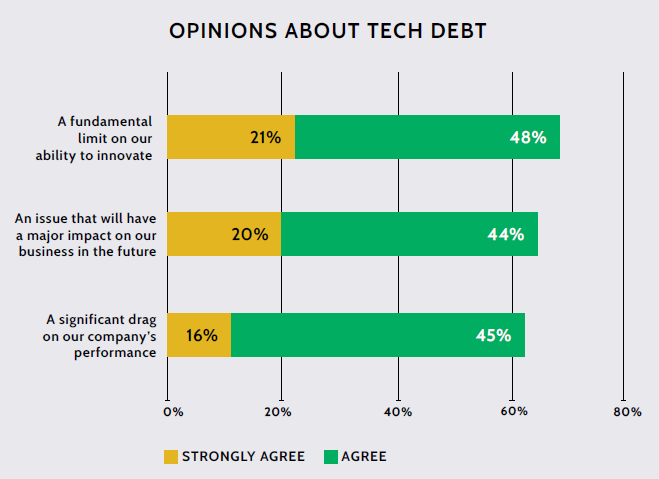OutSystems Survey Finds ‘Technical Debt’ a Major Drag on Innovation
The condition of ‘technical debt’ is proving a major drag on companies efforts to deliver innovation, according to an OutSystems survey. IDN speaks with OutSystems CEO Paulo Rosado about the findings – and how companies can conquer technical debt.
by Vance McCarthy
Tags: application, innovation, IT, legacy, modernization, OutSystems, SaaS, technical debt,

CEO

"The combination of old code, mobile apps, stack applications, and SaaS sprawl are robbing organizations of the ability to innovate."
 Modern Application Development for Digital Business Success
Modern Application Development for Digital Business SuccessA recent report from OutSystems finds that IT execs say a growing amount of "technical debt" is getting in the way of their innovation plans.
The report "The Growing Threat of Technical Debt." examines how companies assess technical debt and the costs it imposes on staying competitive.
"The combination of old code along with the new generation of mobile apps, stack applications, and SaaS sprawl are robbing organizations of resources, time, and the ability to innovate," said OutSystems CEO and founder Paulo Rosado.
The survey also found other causes of technical debt, including:
(a) Too many development languages/frameworks,
(b) Too much turnover among developer teams, and even
(c) The willingness by IT to accept known defects - to meet deadlines
IDN shares some eye-popping excerpts from the OutSystems study and speaks in-depth with Rosado about the perils of "technical debt' and how companies can identify it and steps to remedy the issues it can cause.
Most notably, among the survey findings, more than two-thirds of IT leaders (69 percent) said technical debt "poses a fundamental limit" on their ability to innovate. [In fact, some 61% say the cost of technical debt is so heavy it is a drag on their company's performance.]
The OutSystems report describes how technical debt weighs down budgets and progress:
Technical debt takes a big bite out of company budgets and severely limits the resources businesses can dedicate to developing new capabilities as well as upgrading existing operations.
On average, businesses devote more than a quarter (28 percent) of IT budgets to addressing technical debt compared to about a third (33 percent) to innovating and building new capabilities, and just shy of 40 percent to running status quo operations.
The problem is even more pronounced for enterprise companies, which spend roughly four out of every 10 dollars in their IT budgets on technical debt. In terms of actual spend, that's a serious drain on resources given the amount of money these companies dedicate to IT, and leaves just 30 percent or less in the IT budget for both status quo operations and new capabilities.
"This report proves that technical debt will continue to compound, and requires a new approach to move past it and innovate at a pace and scale for true competitive advantage, Rosado added.
IDN Interviews OutSystems CEO Paulo Rosado on Burden of ‘Technical Debt’
In our IDN interview, Rosado shared some unique perspectives on technical debt to help readers better handle the issue – and begin to set a strategy for hope to alleviate the problem.
IDN: It would seem in many large enterprises, Technical Debt would be tricky to identify. In OutSystems' view, what are the 'symptoms' of technical debt?
Rosado: We define technical debt as the technology and resources spent maintaining old, broken and bad code, rather than developing new software, programs and applications. In other words, it's the coding you have to do now because of the shortcuts you took in the past, and it's keeping you from innovating.
And the problem isn't limited to tech companies; it's a global phenomenon affecting organizations regardless of their location, size or industry. That's why we based our report on a survey of more than 500 IT decision makers at enterprises, commercial entities and SMBs across industries and continents.
We really wanted to get a sense of how they view the problem - and its solutions. We asked respondents to rank factors that contribute to technical debt in their organization, and found that the leading causes were too many development languages and frameworks, followed by turnover in development teams. Other leading causes were the tendency to accept known defects in order to meet release deadlines, and the presence of outdated languages/frameworks.

IDN: Your study mentions 69% of respondents say technical debt "poses a fundamental limit" on their ability to innovate. That's quite a high number. Did respondents identify the limits they are facing?
Rosado: Technical debt is a drain on budgets and resources, and left unchecked will compound over time. As a result, it poses a significant drag on a company's performance, impacting its ability to adapt, grow and innovate, and in some cases undermines financial performance or threatens its very existence.
Our survey found that most organizations are dedicating more than one-quarter of their IT budgets to addressing this problem, which of course limits their ability to run status quo operations and innovate. The problem is even worse for enterprise companies, which spend about four out of every 10 dollars in their IT budgets on technical debt. That's a major drain on resources, especially considering the amount of money these companies spend on tech.
IT leaders in the survey reported that their main strategies to reduce technical debt entail stemming turnover within their development teams and trimming the number of programming languages and frameworks. These are pretty logical solutions, considering businesses identified those as factors contributing the most to the problem.
IDN: Even with 69% respondents saying they have technical debt, only 20% said they manage it well. What should we conclude from this gap?
Rosado: Technical debt builds up and grows silently, through seemingly small decisions based on demands to build fast rather than right.
Business leaders too often ignore or underestimate the problem until it has compounded into a major issue that prevents them from investing in current operations and future innovations.
Even if they're aware of their technical debt load, IT departments are under increased pressure to maintain current systems and build for the future. That's one reason why organizations are adopting no- and low-code solutions at such a fast rate, though the challenge is that many of these tools over-index on speed, and aren't built to change or scale. Addressing technical debt starts with not adding to it in the first place.
Companies have to build in ways that support continuous change, which means building for speed, quality and scale. All three are critical for pulling companies out of their technical debt.
And it's entirely possible to shrink debt by creating a development process that meets short-term deadlines and long-term goals. By carefully aligning modern application development platforms, organizational structures and team priorities, any business can steadily pay off debt without compromising the timelines of their current projects.
IDN: One of your study’s conclusions seems to be that many companies are slow to tackle and resolve their technical debt. Any ideas why?
Rosado: If you dig deep into the survey, you'll discover signs that business leaders may be underestimating technical debt's tendency to compound over time.
For example, while only a small fraction of respondents in the survey expressed confidence in their current efforts to tackle the problem, a higher percentage had a more upbeat outlook about the future. Specifically, just one in five respondents strongly agreed technical debt is something they're currently managing well, while 36 percent noted it's something they'll be able to manage effectively one day.
So these leaders may not be taking enough action right now, because they're confident they can address the problem later on down the road. The problem is that problem will just keep on getting bigger and bigger.
Technical Debt – Pay Now or Pay Later
The bottom line takeaway from the OutSystems survey echoes the famous saying, "You can pay me now, or you can pay me later."
In sum, the report says technical debt, left untreated, will compound as companies grow. And even as businesses put off launching initiatives to address technical debt, it exacts costs on a daily basis upon developers, program managers IT staff – and the entire business, Rosado said.
Read OutSystems’ The Growing Threat of Technical Debt here.
Related:
- InfluxData's Latest Updates Optimize Time Series Data for Better Performance, Scale and Management
- Actian Zen 16.0 Update Simplifies Delivery and Boosts Performance of Edge, IoT Apps
- Virtana Infrastructure Performance Management Adds AI-driven Capacity Planning
- e2open’s Supply Chain SaaS Updates Help Firms Reduce Operational Risks with Deeper Visibility
- Report: Endor Labs Identifies 2023 Operational, Security Risks To Open Source
All rights reserved © 2025 Enterprise Integration News, Inc.



